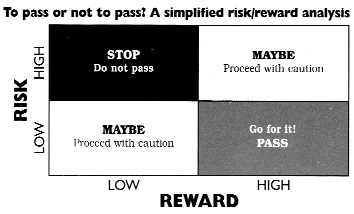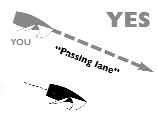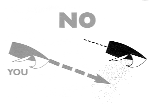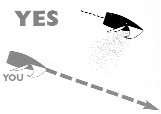
The Art of Passing on a Reach
by David Dellenbaugh
Dave publishes the newsletter Speed & Smarts. For a subscription
call: 800-356-2200 or go to
www.speedandsmarts.com
If you had to pick one place on the race course to pass another boat, it would
probably be on a beat or run because thatís where the boats are far apart. On
reaches, boats often follow each other down the leg, so there are usually fewer
passing lanes. For this reason, your main goal on most reaches should be to get
closer to the boats in front of you and farther ahead of the boats behind. this
will put you in good position to improve your place on the next beat.
Of course, there will be some chances to pass other boats on reaches. When an
opportunity presents itself, the first thing you must do is ask: Will this be
worth it? While there is usually a reward, or benefit, to passing another boat
(e.g. you will move up one place), there is also a risk or cost (e.g. you may be
luffed head to wind in the process). The decision of whether on not to try
passing the other boat depends on how much reward you need and how much risk
youíre willing to take (see box below).
A common mistake on reaching legs is focusing too much on one other boat and
forgetting about the rest of the fleet. Passing is great if it happens quickly
and harmlessly, but if it takes a long time and you have to sail far from the
rhumbline, itís probably not a great idea.
One ďmustĒ pass is when the boat ahead of you is slow and itís the beginning of
a long reach. The longer you stay behind this boat, the more distance you will
lose to the entire fleet. Another good time for a pass is when the boat ahead
makes a mistake like sailing too low or losing control of their chute.
Here are some tips on how you can be a better passer and also avoid getting
passed.
Go on the offensive
When you begin a reach, look at the boats in front of you to see if passing may
be a possibility. If it is, try to set yourself up in a good position as
possible.
Like most other moves in sailing, passing seldom works well when it is
spontaneous or an afterthought. The last thing you want to do is come right up
behind another boat and then try to pass them.From this position you will not be
able to get very far away. If you try passing them to leeward, youíll get stuck
in their bad air (Situation 3). If you go to windward (Situation 1), they will
almost always luff you, making it nearly impossible to pass and often taking you
well off your chosen course.
To prevent this, decide early whether you will go to windward or leeward of the
boat ahead. Then start working up or down so you are at least several
boatlengths away from the other boat when you pass them (Situations 2 and 4).
You have to be far enough above them that they wonít try to luff you, or far
enough to leeward that you will be clear of their bad air. Remember that wind
shadows extend farther to leeward in light air, which is why the low road can be
a little tough in those conditions. One factor in favor of going high on the
second reach is that this will put you inside at the next mark. Of course, you
must consider many other factors in this decision.
Whether you go high or low, try to be outside (in front of) the lead boatís
quarter wake when you are overtaking them. If you get stuck inside (behind) the
wake of a slower boat, you may never get past them.
Donít let other boats roll you
Itís great to be able to pass other boats, but sometimes itís even more
important to avoid being passed yourself. You can do this by sailing fast and
smart so itís hard for anyone else to pass you. As they say in other sports, the
best defense is usually a good offense.
When other boats do threaten you from behind, think about how much are you
willing to fight to keep them from passing. If youíre racing on handicap and a
larger boat is overtaking you, maybe itís best to let them roll you quickly
(then catch their wave if possible).
In most situations, the best defense against being passed is to stay high. Of
course, you shouldnít sail too far above the rhumbline or youíll lose to the
fleet. Instead, sail just high enough (slightly to windward of the other boatís
course) so they know there is no way you will let them sail over you. Get into
this position early (before they are committed to passing you to windward), and
show them youíre ready and willing to luff hard. Hopefully this will discourage
them enough so theyíll either follow behind you or try passing you to leeward.

Trying to pass a boat on a reach is a lot like other moves you make on the race course - before you do it you should think about the potential rewards and risks. One obvious reward is that you may move up a place in the race. If the boat you pass is your closest competitor in the regatta, the reward of doing this would be ďhigh.Ē Of course, there are also risks. If the skipper of the other boat is aggressive and may luff you head to wind, then the risk could also be high. Whether or not you actually try to make the pass depends on this risk-to-reward ratio and your position in the race or series.

1.You should almost never try passing another
boat close to windward. Weíve all done this and itís a bad idea because the
other boat usually defends her position aggressively by luffing.
This creates three problems: 1) It will be difficult or impossible to pass the
other boat; 2) If you sail high to get over this boat, you will lose distance to
every other boat in the fleet; and 3) You will be stuck behind this boat for the
rest of the reach (and therefore go slower).
The main reason why people try to pass close to windward of other boats is
because they donít think ahead. They sail up right behind the other boat and
then have no choice but to pass very close on one side or the other.

2.Passing another boat to windward is a good
idea because you keep your air clear and, on the second reach, youíll be inside
at the leeward mark. To do this effectively, you have to get up early into the
ďpassing lane.Ē
The passing lane is an area thatís at least several boatlengths to windward of
the boats ahead. Itís far enough away that you can roll over them and they wonít
be able (or they wonít try) to stop you. The main requirement is that you get
into the passing lane at least several lengths before you reach the other boat.
This way they wonít be tempted to sail up in front of you.

3.Trying to pass another boat close to leeward
is about as hopeless as passing them close to windward (except they wonít be
able to luff you). Itís not bad at the end of the first reach when low is
inside, but unless your boat is much faster; you wonít be able to sail through
another boatís wind shadow.
This leeward passing move becomes even tougher when the wind is light, the reach
is tight, or when you have more than one boat ahead. Once again the usual
problem is your approach. If you come up right behind another boat, it will be
tough to sail low and get far enough away to pass them to leeward.

4.If you want to pass another boat to leeward,
try to be far enough away so you avoid their wind shadow completely, especially
in lighter air. To do this, you must start working low well before you reach
them (get in the leeward ďpassing laneĒ) - otherwise you will have to bear off a
lot to get below them and you will lose too much speed.
On the second reach, going low will put you outside at the next mark, so donít
choose this option unless the boats ahead are sailing quite high or unless
strategic factors (e.g. current flowing against the wind) favor the low road
pretty strongly.